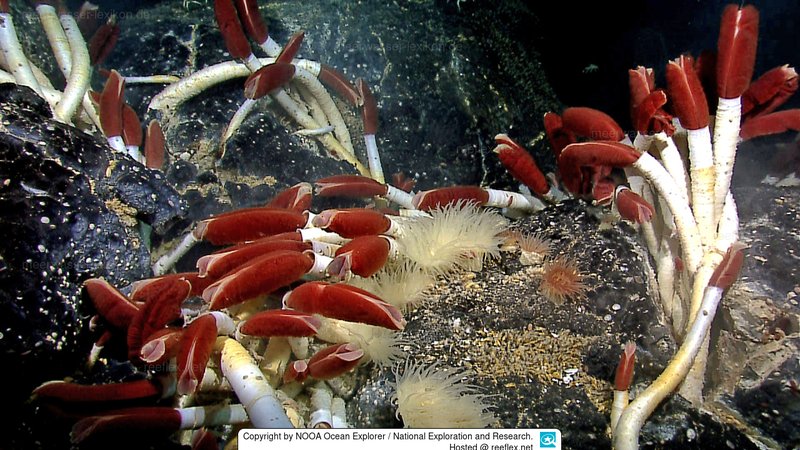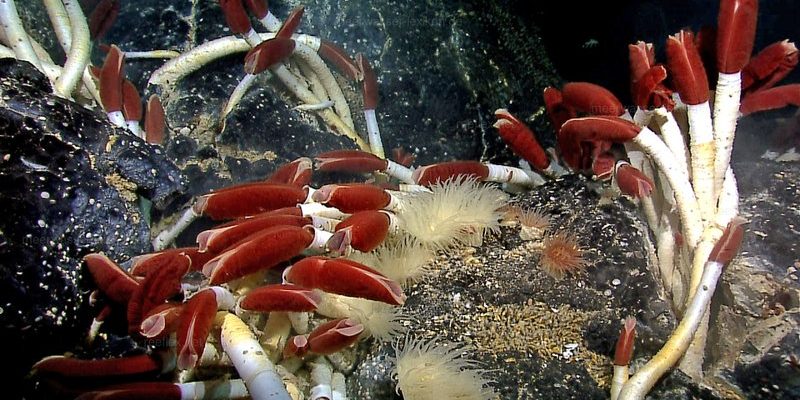
When you delve into the world of Riftia pachyptila, you quickly realize it’s not just about survival—it’s about thriving in the depths of the ocean. Understanding their habitat preferences helps us learn about their role in the ecosystem and the delicate balance of marine life. So, grab your favorite drink, and let’s explore where these incredible creatures call home.
Where Do Riftia Pachyptila Live?
Riftia pachyptila primarily inhabit hydrothermal vent environments found along mid-ocean ridges. These vents are like nature’s geothermal heaters, releasing superheated water and minerals from the Earth’s crust. The temperatures can reach up to 400°C (752°F), yet these tube worms flourish where most life would perish. It’s truly remarkable how life can adapt to such extreme conditions!
Their habitats aren’t just any random spot along the ocean floor; these worms prefer areas with stable and well-established hydrothermal vents. They often cluster in large populations around these vents, establishing communities that can include thousands of individuals. Imagine a bustling underwater neighborhood, each worm tucked inside its protective tube, creating a vibrant living space filled with life.
The Importance of Hydrothermal Vents
Hydrothermal vents play a critical role in the ecosystem where Riftia pachyptila thrive. These vents release a cocktail of chemicals, including hydrogen sulfide, which is toxic to most organisms. However, for these giant tube worms, it’s a lifeline. They have a special relationship with the bacteria that live inside them, which can process these harmful chemicals into usable energy, like a natural power plant.
These ecosystems are not only vital to the worms but also to various other organisms. The vents create a unique habitat for various species, from shrimp and crabs to other forms of life that rely on this nutrient-rich environment. This interconnectedness highlights how the habitat preferences of Riftia pachyptila contribute to a broader community of marine life.
Temperature and Depth Preferences
When discussing habitat preferences, temperature and depth are key factors for Riftia pachyptila. These worms typically inhabit depths ranging from 2,500 to 3,000 meters (8,200 to 9,800 feet) below sea level. The water pressure at these depths is immense, but these worms have adapted their bodies to withstand such extreme conditions.
The temperature in their habitat varies significantly, yet they thrive best in areas where the vent water is heated to temperatures around 30-90°C (86-194°F). This range allows them to access the nutrients they need while avoiding extreme heat that could be damaging. Each vent’s unique characteristics can create microhabitats with varying conditions, potentially influencing their distribution.
Substrates and Location
Riftia pachyptila prefer to anchor themselves to hard substrates near the hydrothermal vents. The ocean floor is often rocky, providing a stable footing for their tubes. These tubes can be several meters long, providing a protective home for the worms. You might think of it like a cozy apartment: spacious enough to accommodate their growth and shield them from predators.
The location of these vents is crucial, as they can change over time due to geological activity. When a vent becomes inactive, tube worms may not survive if they can’t relocate to a new active site. This dependency on specific substrate types and vent activity emphasizes how fragile their habitat can be.
Feeding and Nutritional Needs
Feeding habits are another essential aspect of habitat preferences for Riftia pachyptila. Unlike most creatures that rely on sunlight and photosynthesis, these worms have evolved to thrive in darkness, relying entirely on their symbiotic bacteria for nourishment. The bacteria live within their bodies and convert hydrogen sulfide, carbon dioxide, and oxygen into organic compounds.
This partnership allows the worms to absorb nutrients directly from the surrounding water, almost like having a buffet right at their fingertips. It’s a remarkable adaptation that allows them to exploit their unique environment efficiently. The nutrient-rich environment created by the hydrothermal vents is a key part of what makes these habitats so suitable for the tube worm.
Threats to Habitat and Conservation
Despite their amazing adaptations, Riftia pachyptila and their habitats face threats from human activities. Hydrothermal vents are increasingly targeted for deep-sea mining and exploration, which can lead to habitat destruction. Disturbing these delicate ecosystems could have significant impacts not just on the worms but on entire marine communities.
Another concern is climate change, which could alter ocean temperatures and chemistry. As conditions change, the stability of hydrothermal vents may be affected, disrupting the delicate balance that supports life like Riftia pachyptila. Conserving these habitats is critical for maintaining the biodiversity and health of our oceans.
In summary, the habitat preferences of Riftia pachyptila reveal much about these extraordinary deep-sea creatures. From their unique adaptations to thrive in extreme environments to their dependence on hydrothermal vents, every aspect of their lives contributes to the complex web of marine life. Understanding their needs and the challenges they face is crucial for ensuring their survival and the health of their ecosystems.
As we continue to explore the mysteries of the deep ocean, let’s remember the importance of protecting these incredible habitats. After all, every creature, no matter how small, plays a part in the intricate dance of life beneath the waves. So, next time you think about the ocean, consider the resilience of the Riftia pachyptila and the wondrous environments they call home.

